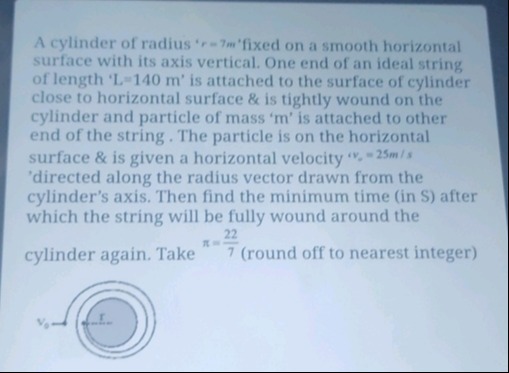Question
Question: A cylinder of radius 'r=7m'fixed on a smooth horizontal surface with its axis vertical. One end of a...
A cylinder of radius 'r=7m'fixed on a smooth horizontal surface with its axis vertical. One end of an ideal string of length 'L=140 m' is attached to the surface of cylinder close to horizontal surface & is tightly wound on the cylinder and particle of mass 'm' is attached to other end of the string. The particle is on the horizontal surface & is given a horizontal velocity 'v₀=25m/s 'directed along the radius vector drawn from the cylinder's axis. Then find the minimum time (in S) after which the string will be fully wound around the cylinder again. Take π=722 (round off to nearest integer)

11
14
7
25
11
Solution
The problem describes a particle attached to a string wound around a cylinder. The particle is given an initial velocity perpendicular to the string, directed radially outward. This scenario leads to the particle tracing an involute of the circle.
-
Conservation of Angular Momentum: The cylinder is fixed, and the string is ideal. The tension in the string acts towards the axis of the cylinder, and thus exerts no torque about the axis. Therefore, the angular momentum of the particle about the axis of the cylinder is conserved.
-
Initial Conditions: At the moment the particle is given velocity v0, it is at a distance R0=r from the cylinder's axis, and its velocity v0 is directed radially outward. The angular momentum is given by L=Rmvsinα, where α is the angle between the position vector R and the velocity vector v. Initially, R0 is radial and v0 is also radial. Thus, the angle between them is 0∘. So, the initial angular momentum is L0=R0mv0sin(0∘)=rmv0×0=0.
-
Motion of the Particle: Since angular momentum is conserved and the initial angular momentum is zero, the angular momentum must remain zero throughout the motion. This implies that at all times, the velocity vector v must be collinear with the position vector R. In other words, the particle must always move radially.
-
String Winding and Unwinding: The string is attached to the cylinder and to the particle. As the particle moves radially, the string either unwinds or winds up.
- When the particle moves radially outward, the string unwinds. The length of the unwound string is s=R−r.
- When the particle moves radially inward, the string winds up.
-
Energy Conservation: The surface is smooth, and the string is ideal. The tension does no work as the particle moves radially (tension is along the string, and the displacement is also along the string). Therefore, the kinetic energy of the particle is conserved. Initial kinetic energy: K0=21mv02. At any later time, when the particle is at a distance R from the axis and has a radial velocity vR, its kinetic energy is K=21mvR2. Since angular momentum is conserved and the motion is radial, the velocity v is always radial, so v=vR. Thus, K=21mv2. By conservation of energy, K=K0, so 21mv2=21mv02. This implies v=v0.
-
Time Calculation: Since the particle moves radially with a constant speed v=v0, the time taken to travel a distance ΔR is Δt=v0ΔR. The particle starts at R0=r and moves radially outward. The total length of the string is L. The string is fully wound when the particle is at a distance R=r from the axis. The question asks for the minimum time after which the string will be fully wound around the cylinder again. This implies the particle must move outwards, then return inwards until the string is fully wound.
Let's consider the motion. The particle is given velocity v0 radially outward. The string unwinds. The maximum radial distance the particle reaches is when the entire string of length L has unwound, so Rmax=r+L. After reaching this maximum distance, the particle must reverse its direction of motion and move radially inward. For the string to be fully wound, the particle must return to a distance R=r from the axis.
The total radial distance traveled outward is L. The time taken to reach Rmax is tout=v0L. The particle then moves radially inward from Rmax=r+L to R=r. The distance traveled inward is also L. The time taken to move inward is tin=v0L. The total time until the string is fully wound again is ttotal=tout+tin=v0L+v0L=v02L.
-
Calculation: Given: r=7 m, L=140 m, v0=25 m/s, π=722. Time t=v02L=25 m/s2×140 m=25280 s=556 s=11.2 s.
-
Rounding Off: The question asks to round off to the nearest integer. 11.2 rounded to the nearest integer is 11.
